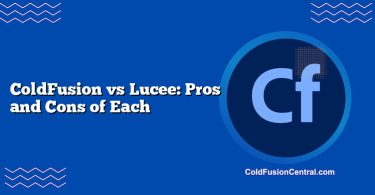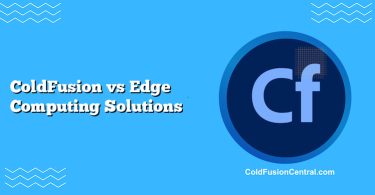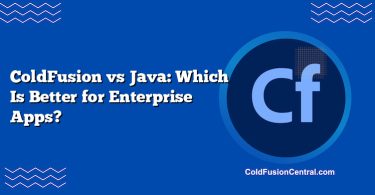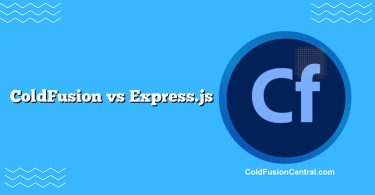Definitions
-
ColdFusion (CFML platform): A server-side, rapid application development stack built on the JVM that uses the CFML language. Offered as Adobe ColdFusion (commercial) and Lucee (open-source), it provides built-in services for web apps and APIs, including PDF generation, mail, image processing, scheduling, and robust integration features.
-
No-code builders: Visual development platforms (e.g., Bubble, Webflow, Glide, Airtable Interfaces, AppSheet) that let users create applications via drag‑and‑drop UI, declarative workflows, and prebuilt integrations—without writing traditional code. They emphasize speed, templates, and managed hosting.
Overview
What ColdFusion Really Is
ColdFusion is a server-side application server with a tag- and function-based language (CFML). It compiles to Java bytecode, runs on Tomcat/JVM, and integrates easily with databases and HTTP services. Devs often pair CFML with frameworks like ColdBox, FW/1, or cbORM, and use CommandBox + ForgeBox for CLI/package management. You control the code, runtime, and deployment model—on-premises or cloud.
What No-Code Builders Really Are
No-code builders provide visual UI editors, drag‑and‑drop components, workflow automation, prebuilt integrations, and one-click deployment. They’re ideal for internal tools, marketing sites, data dashboards, and MVPs. Some tools blur into low-code, offering custom code extensions or scripting when needed.
Why Compare Them?
Teams often face a choice: build with a conventional platform (like ColdFusion) for flexibility and performance, or use a no-code platform for speed and simplicity. The right option depends on complexity, compliance, scale, budget, and timelines.
Key Features
ColdFusion: Core Capabilities
- CFML language with expressive tags and functions
- Built-in services: PDF, spreadsheet, image, mail, scheduling, websockets, REST, caching
- Data access: JDBC, ORM (Hibernate-based in Adobe ColdFusion, cfORM in frameworks)
- Cloud connectors: AWS/Azure/GCP services (varies by edition/version)
- Asynchronous processing: cfthread, futures, queues
- Security features: secure profiles, hardened installers, centralized configs, ESAPI-inspired functions
- Modern tooling: CommandBox dev servers, package management (ForgeBox), testing (TestBox)
- Framework ecosystem: ColdBox, WireBox (DI), CacheBox, LogBox, cbORM
No-Code Builders: Core Capabilities
- Visual UI design: drag-and-drop pages, responsive layouts
- Workflow automation: event triggers, conditional logic, actions
- Data modeling: built-in DBs, connectors to Airtable/Google Sheets/SQL
- Integrations: REST connectors, SaaS apps (Stripe, Slack, Zapier/Make)
- Auth and access control: roles, permissions, SSO in some platforms
- Templates and components: quickly assemble common flows
- Managed hosting and scaling: vendor operates the runtime and infrastructure
- Plugin/extension marketplaces: extend functionality without custom server code
Performance
ColdFusion Performance Profile
- Runs on the JVM, delivering compiled CFML and access to Java libraries.
- Caching (RAM, distributed) and connection pooling enable high throughput.
- Optimizable with JVM tuning, query optimization, object pooling, and efficient CFML patterns.
- Suited for compute-heavy tasks, high-frequency APIs, and complex data shaping.
- Can integrate Nginx/Apache for reverse proxying, HTTP/2, and caching.
No-Code Performance Profile
- Performance is platform-managed; you benefit from their global infrastructure but are bound by platform limits.
- Heavy logic or large datasets can hit query limits, rate limits, or latency from abstraction layers.
- Front-end rendering is typically responsive for CRUD and standard pages but may degrade with very large datasets or custom visualizations.
- Good for light to medium workloads, internal apps, and MVPs; less ideal for high-frequency, low-latency APIs.
Scalability and Deployment
ColdFusion Scalability and Deployment
- Horizontal scaling via multiple nodes behind a load balancer.
- Clustering and session replication (Enterprise features in Adobe CF).
- Containerization with Docker; CI/CD via Jenkins/GitHub Actions/GitLab.
- Cloud-agnostic: deploy on AWS, Azure, GCP, or on-premises.
- Fine-grained infrastructure control and observability (APM, logs, PPMT for Adobe CF).
No-Code Scalability and Deployment
- Auto-scaling handled by the vendor (within plan limits).
- No servers to manage; easy one-click deployment and rollbacks.
- Plan-based ceilings on storage, API calls, and concurrency; upgrades remove some limits.
- Less control over network topology, data residency, and multi-region deployments unless offered by the vendor.
Security and Compliance
ColdFusion Security
- Secure profile installations, lockdown guides, admin hardening.
- Programmatic defenses: input validation, encoding, CSRF tokens, secure cookies.
- You own the patching: OS, JVM, CF engine updates; WAF and network controls are your responsibility.
- Compliance (e.g., HIPAA, PCI DSS, GDPR) is achievable when you manage infra, processes, and audits.
No-Code Security
- Vendors often maintain SOC 2/ISO 27001; some provide HIPAA-ready tiers and data encryption.
- Platform-level login, SSO, and RBAC reduce custom security effort.
- You rely on the vendor for patching, DDoS, network security, and data residency. Verify BAAs and regional data storage if required.
- Risk of vendor lock-in and limited control over transport and storage layers.
Cost and Licensing
ColdFusion Costs
- Adobe ColdFusion: licensed (Standard/Enterprise), typically per-core; can be significant for large deployments.
- Lucee: open-source CFML engine, no license costs; optional paid support.
- Additional costs: infrastructure, DB licenses, APM, DevOps, maintenance.
- Predictable at scale; favorable TCO when you have sustained heavy workloads and long-lived apps.
No-Code Costs
- Subscription-based: per-user, per-app, or usage-tiered pricing.
- Extras: API call overages, plugin fees, storage/bandwidth upgrades.
- Excellent for early stage and prototypes; costs may grow steeply with scale or complex logic that requires higher-tier plans.
- Migration costs later can be significant due to platform-specific models.
Community and Ecosystem
ColdFusion Community
- Active communities around Lucee and Adobe CF; meetups, CF Summit, Into The Box.
- ForgeBox ecosystem for packages; frameworks like ColdBox, cbWire, qb (query builder).
- Mature ecosystem for APM, CI/CD, containerization, and observability.
No-Code Community
- Large user bases for Bubble, Webflow, Glide, Airtable, AppSheet.
- Extensive template marketplaces, plugin stores, and tutorials.
- Rapid community-led patterns for design, workflows, and integration hacks.
Supported Platforms and Deployment Models
-
ColdFusion (Adobe/Lucee)
- OS: Windows, Linux, macOS (dev)
- App servers: Tomcat (bundled) or other servlet containers (varies)
- Databases: MySQL, PostgreSQL, SQL Server, Oracle, etc.
- Hosting: On-prem, VMs, containers, cloud instances
- Export: Full source code ownership, JVM portability
-
No-Code Builders
- Targets: Web apps, PWAs, some offer mobile wrappers or native builds
- Data sources: Built-in DBs, Airtable, Google Sheets, REST/GraphQL, SQL connectors
- Hosting: Typically vendor-managed; limited self-host options
- Export: Often no full source export; emphasis on in-platform maintenance
Real-World Scenarios
When ColdFusion Is Preferred
- A regional healthcare provider needs a secure scheduling and referral system integrated with legacy HL7 interfaces, hospital SSO, and on-prem databases. The team must comply with HIPAA, control network policies, and support high‑volume data processing.
- ColdFusion advantages:
- Direct JDBC and messaging integrations
- Fine-grained security hardening
- Horizontal scaling and caching for performance
- Rich PDF/spreadsheet capabilities for reports and forms
- ColdFusion advantages:
When No-Code Is Preferred
- A startup wants to test a marketplace MVP within weeks, iterate daily on UX, integrate Stripe, and gather user feedback. They have no backend engineers.
- No-code advantages:
- Drag-and-drop pages and workflows for fast iteration
- Managed auth, payments, and email integrations
- Templates accelerate onboarding; low upfront cost
- Easy A/B testing and rapid deployment without DevOps
- No-code advantages:
Side-by-Side Comparison
| Dimension | ColdFusion (CFML) | No-Code Builders |
|---|---|---|
| Performance | High, JVM-backed, optimized caching and DB access | Moderate; platform-managed, may hit usage/latency limits |
| Scalability | Full control: clustering, load balancers, containers | Auto-scales within plan limits; less infra control |
| Development Speed | Fast for devs; scaffolding and built-in services | Very fast for non-devs; visual builder and templates |
| Flexibility | Very high; custom libraries, Java interop | Constrained by platform features and plugin ecosystem |
| Hosting Control | Complete (on-prem/cloud/containers) | Vendor-managed; limited self-hosting |
| Security & Compliance | You manage and can meet strict standards | Vendor attestation; check HIPAA/BAA, residency options |
| Cost | License (Adobe) or free (Lucee) + infra; predictable at scale | Subscription + usage; cheap early, can grow expensive |
| Vendor Lock-in | Low (open stack, code ownership) | Medium–High (data/models are platform-specific) |
| Best Use Cases | Complex integrations, high-throughput APIs, regulated environments | MVPs, internal tools, marketing sites, CRUD dashboards |
| Pros | Control, performance, extensibility, compliance | Speed, simplicity, managed infra, templates |
| Cons | Ops overhead, need engineering skills, license costs (Adobe) | Limits, lock-in, complex logic workaround costs |
Pros and Cons
ColdFusion (CFML) Pros
- High performance on the JVM with mature optimization paths
- Deep integration options (databases, services, libraries)
- Full code and hosting control, on-prem or cloud
- Strong built-in features: PDF, mail, scheduling, caching
- Long-term maintainability with open-source option (Lucee)
ColdFusion (CFML) Cons
- Operational responsibility: patching, monitoring, scaling
- Licensing costs (Adobe editions) for certain deployments
- Requires engineering expertise and DevOps maturity
No-Code Builders Pros
- Rapid time-to-value with visual development
- Managed hosting: no servers, patches, or ops burdens
- Rich integrations and templates out of the box
- Great for non-developers and small teams
No-Code Builders Cons
- Vendor lock-in and limited source export
- Performance/usage caps and constrained custom logic
- Potential compliance/data residency limitations
- Costs can escalate at scale or with advanced features
Decision Factors / Which One Should You Choose?
-
Choose ColdFusion if:
- You need complex business logic, custom integrations, or low-latency APIs
- Compliance or data residency requires infrastructure control
- You plan for long-lived systems with predictable scaling and code ownership
- Your team has or can hire backend/DevOps expertise
-
Choose No-Code if:
- You must ship an MVP or internal tool rapidly with minimal engineering
- The app is CRUD-centric with standard workflows and integrations
- You prefer managed hosting and can live within platform constraints
- You need to validate a market before investing in custom build
-
Hybrid approach:
- Start with no-code to validate, then migrate critical services to CFML APIs
- Use no-code for front-end/admin workflows, ColdFusion for heavy backend tasks
- Plan data models and integrations to minimize lock-in (e.g., external DB, REST APIs)
Key Takeaways
- ColdFusion provides power, control, and scalability for complex, long-lived applications—at the cost of operations and (for Adobe CF) licenses.
- No-code builders deliver speed and simplicity, ideal for MVPs and internal tools, but introduce platform constraints and lock-in risks.
- Consider performance, compliance, cost trajectory, and team skills. A hybrid path often yields the best of both worlds: quick wins now, maintainable scale later.
FAQ
Is ColdFusion still relevant, or is it a legacy technology?
Yes. Adobe ColdFusion continues to receive updates and enterprise support, and Lucee provides a modern open-source CFML engine. With JVM performance, container support, and ecosystem tooling (CommandBox, ColdBox), CFML remains viable for web apps and APIs.
What’s the difference between no-code and low-code?
No-code targets non-developers, emphasizing visual building without traditional code. Low-code offers similar visuals but includes extensibility via scripts/components and custom code, enabling more complex logic and integrations.
Can a no-code app scale to millions of users?
It depends on the platform, app design, and plan. Some no-code apps scale well for typical workloads, but extreme concurrency or complex processing often requires custom backends or eventual migration to conventional stacks.
Can I migrate from a no-code prototype to ColdFusion later?
Yes. A common pattern is to keep the no-code front-end initially and gradually offload heavy logic to CFML-based APIs, then replace the front-end once product requirements stabilize. Plan early for data portability and API-first architecture.
Is Lucee a drop-in replacement for Adobe ColdFusion?
Lucee is highly compatible with CFML but not a perfect drop-in for every Adobe CF feature (especially enterprise-specific services). Many apps run fine on Lucee with minor adjustments. Evaluate your use of Adobe-specific features before switching.




